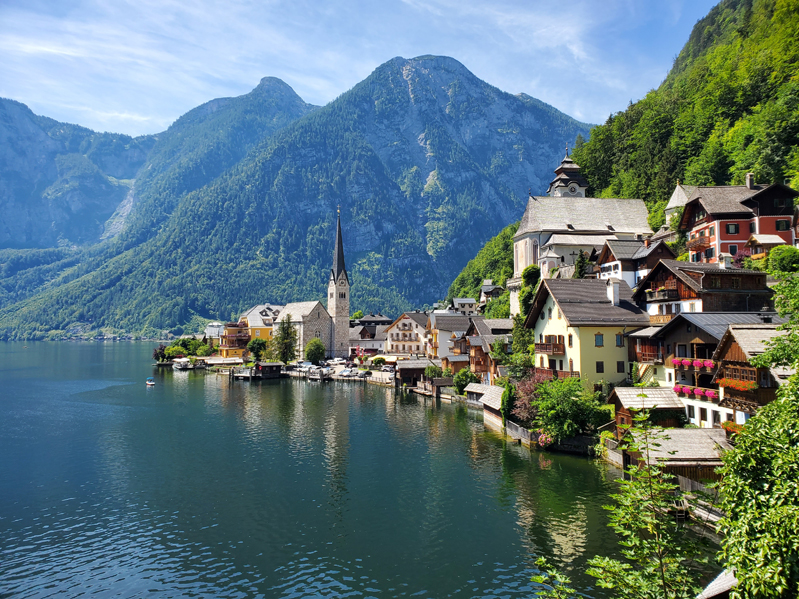Hallstatt, this picturesque alpine town located in the snowy mountains of the federal state of Upper Austria in Austria and is located on the southwestern shore of Lake Hallstatt.
Information about the village appears in written sources since 1311. About the medieval history of Hallstatt almost no data has been preserved due to its remoteness from the means of communication. Since 1595, dissolved salt has been transported via the world’s oldest pipeline to Ebense, located 40 km from Hallstatt.
Hallstatt is small and consists of a central square with a town hall, a road along the lake, and a small number of houses that can be reached by steep stairs.
This lakeside village has cafes, bakeries, a supermarket and souvenir shops.since 1997,Hallstatt is at the core of the “Hallstatt-Dachstein/Salzkammergut Cultural Landscape” ,also Hallstatt was listed as a UNESCO World Heritage Site. Today Hallstatt receives over 1 million visitors a year.
Access : Coordinates: 47.562, 13.649 /
Highlights :
- Hallstättersee – Lake Hallstatt : The 8.5 km² large lake is the most impressive in the Salzkammergut. In addition to fishing, the lake is also used for tourism, be it for swimming or diving. Also , the lake can be navigated with a typical Salzkammergut boat.
- Catholic parish church Maria Himmelfahrt, Maria am Berg: The late Gothic parish church Maria Himmelfahrt, completed in 1505.
- Karner: On the north side of the church in the cemetery is the Karner with the small ossuary, which dates back to the 16th century.
- Hallstatt Museum: The museum owns, alongside the Natural History Museum Vienna, the second extensive collection of finds from the Hallstatt period in Austria.
- Hallstatt burial ground and salt tunnels: A footpath and the salt mountain railway lead up to the Hallstatt burial ground and the salt tunnels – the oldest in the world. From 1282 to 1284, Duke Albrecht I of Austria had the Rudolfsturm built here, which was named after his father, Rudolf I. It served as a defensive structure during the salt war against Archbishop Konrad IV of Salzburg and was the home of the respective miner from 1313 until the middle of the 20th century. Today the tower houses a restaurant that is popular because of its view. The salt mine can be visited as part of a 70-minute tour.
- Salt mountain – Salzberg : The easiest way to get to the oldest salt mine in the world is by taking a panorama train, which climbs 360 m from the 3 valley station within 3 minutes. Your 4 mountain station is next to the Rudolfsturm, which was built in the 13th century to protect the salt deposits. There is a restaurant in the tower, in front of which there is access to the 2 Skywalk, a terrace with a world heritage view.
- The center of Hallstatt : the beautiful and flourishing center of Hallstatt. Colorful buildings, flowers and decorations on trees and houses.
- The observation deck of the village – all the photos that you see on Instagram, well, or almost all, were taken from this point.
- These places are famous for their salt deposits all over the world. Here are the oldest salt mines in Europe.
- This region of Austria is known for schnapps. Schnapps is a strong alcoholic beverage with an alcohol content of at least 40%. Schnapps is a distillate obtained from plums, pears, grapes and apricots.
- traditional Christmas markets lining the streets of the town, and white snow enveloping the village.
- Together with the Dachstein and the Inner Salzkammergut, it is part of the Hallstatt-Dachstein / Salzkammergut UNESCO World Heritage Site.
- Chinese copy : In 2012, in Luoyang City, Guangdong Province, Minmetals Mining and Metals Corporation built a replica of the village.
- From autumn 2020, coaches will only be allowed to drive in and allow their groups to disembark in time slots previously allocated by the local tourist office and only offered in a limited way. The regulation includes, among other things, that every bus must stay in Hallstatt for at least 2.5 hours and a fee of € 80 must be paid.
Events : Salzkammergut Mozart Festival: annual festival in July and August / Hallstatt Kulturell: is a series of events in summer; There is a free concert every Tuesday / Hallstättersee-Rundlauf: the Hallstättersee-Rundlauf, a half marathon, has been taking place on the first weekend in May since 1987 /
Hallstatt swimming marathon: for the first time in 2011, athletes swim along the west bank from Bad Goisern via Hallstatt to Obertraun./ Lake procession on Lake Hallstatt: On Corpus Christi day, a well-known lake procession has taken place on Lake Hallstatt every year since 1623.
Activities : sightseeing / photo opportunities, The most beautiful photos of the city are taken in winter, when the town is shrouded in a blanket of snow, or in spring, when the area is buried in greenery and flowers./ You can take a boat ride from the main station to the center of Hallstatt / Mountain biking – most forest roads in the region are approved for this, racing biking, gravel biking, cycling / Speigerlift ski lift – small lift that can be used as a beginner lift, especially for children./ Snowshoeing – equipment can be rented on site.
– Skiing in the Freesports Arena Dachstein Krippenstein – only 7 km from Hallstatt.
Go next : the town of Obertraun. a village in the Salzkammergut, a region in Austria. / Linz , the capital city of Upper Austria and third-largest city in Austria./ Steyr , a statutory city located in the Austrian federal state of Upper Austria.

